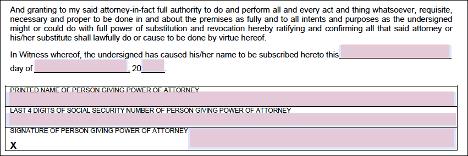Ohio Vehicle Power of Attorney (Form BMV 3771)
An Ohio motor vehicle power of attorney (Form BMV 3771) is a document used to give an individual (the attorney-in-fact) the ability to take care of the owner’s vehicle-related affairs. The vehicle owner uses the form when they cannot tend to the matter themselves (or do not wish to). Once signed, the owner must file the motor vehicle power of attorney with the Ohio Bureau of Motor Vehicles (BMV). This step allows the attorney-in-fact to sign documents and make decisions on behalf of the owner. Additionally, it protects the owner from fraudulent transactions, especially if a person has stolen the vehicle. If the attorney-in-fact buys or sells the vehicle privately (i.e., at a location other than the Ohio BMV), they must hold a copy of the form and present it to the buyer or seller.
The attorney-in-fact must act in accordance with the owner’s wishes. To restrict the attorney-in-fact’s power, the owner can attach and sign a separate form that lists the given responsibilities. Having the information in writing protects the owner if the assigned person makes choices that do not align with their wishes. However, the owner does not need to attach another form. Instead, both parties can verbally discuss the duties, especially if the attorney-in-fact is trustworthy and reliable. Choosing a family member, close friend, or business partner over the age of eighteen (18) ensures that the person will make warranted choices.
Signing requirements: The vehicle owner must sign in the presence of a Notary Public.
How to Write
Download: PDF
Step 1 – Agent and Description of Car
This first section contains the information about the agent (attorney-in-fact) and the vehicle for which the agent will be responsible. Write the agent’s name (last, first, middle initial), street address, city, state, and zip code. Then provide the car’s make, year, and VIN (Vehicle Identification Number).

Step 2 – Owner Information and Signature
The owner fills in the current date (e.g., 13th day of October 2021), his/her name, and the last four digits of his/her Social Security Number.

Step 3 – Notarization
Having the Notary Public present, the owner signs his/her name. The Notary Public will then complete the document by officially acknowledging it with his/her Notary Seal.

